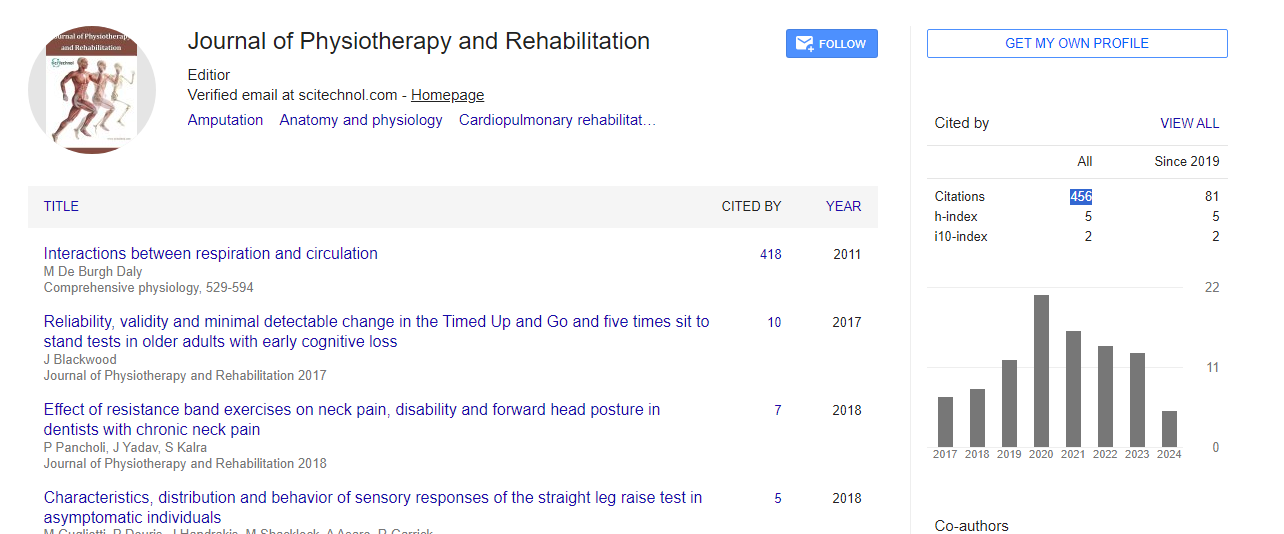Perspective, J Physiother Rehabi Vol: 6 Issue: 2
Potential of Regenerative Medicine in Cerebral Palsy Treatment
Mintaz Paynter*
Faculty of Health Sciences, Department of Physiotherapy and Rehabilitation, Hacettepe University, Ankara, Turkey
*Corresponding Author: Mintaz Paynter
Faculty of Health Sciences, Department of Physiotherapy and Rehabilitation, Hacettepe University, Ankara, Turkey
E-mail: mintpaynter@hacuni.tr
Received date: 22 March, 2023, Manuscript No. JPTR-23-99186;
Editor assigned date: 24 March, 2023, Pre QC. JPTR-23-99186 (PQ);
Reviewed date: 15 April, 2023, QC No. JPTR-23-99186;
Revised date: 22 April, 2023, Manuscript No. JPTR-23-99186 (R);
Published date: 28 April, 2023, DOI: 10.4172/JPTR.1000127
Citation: Paynter M (2023) Potential of Regenerative Medicine in Cerebral Palsy Treatment. J Physiother Rehabi 7:2.
Description
Cerebral Palsy (CP) is a neurological condition that affects movement and posture, caused by damage to the developing brain, and can occur before, during, or shortly after birth. While there is no cure for CP, many therapies and treatments can help individuals manage their symptoms and improve their quality of life.
Assistive technology
Assistive technology includes devices such as wheelchairs, communication devices, and orthotics, and has revolutionized the way individuals with CP can communicate, move, and interact with their environment. Exoskeletons are wearable devices that support an individual's body and provide mobility assistance. They can help individuals with CP stand, walk, and move more independently, allowing them to participate in activities that were previously out of reach.
Regenerative medicine
Regenerative medicine is a rapidly evolving field that involves the use of stem cells to repair or replace damaged tissue. Stem cells have the ability to differentiate into different cell types and can be used to regenerate damaged tissue in the brain and other parts of the body. This approach has shown confidence in the treatment of CP, as it may be possible to repair the damaged neurons that cause the condition. Several clinical trials are currently underway to evaluate the safety and efficacy of stem cell therapy for CP.
Virtual reality therapy
Virtual reality therapy uses immersive technology to simulate reallife experiences. This therapy can help individuals with CP improve their motor skills, balance, and coordination. Virtual reality therapy involves wearing a headset that displays a 3D environment and using a controller to interact with the environment. This therapy can be customized to fit an individual's specific needs and abilities and has shown confidence in several clinical trials.
Botulinum toxin injections
Botulinum toxin injections are a well-established treatment for spasticity, a common symptom of CP. This muscle relaxant is injected directly into the affected muscle, blocking the release of acetylcholine, a neurotransmitter that is involved in muscle contractions. New formulations of botulinum toxin have emerged that are more potent and longer-lasting than previous formulations, providing sustained relief from spasticity.
Therapeutic ultrasound
Therapeutic ultrasound is a non-invasive treatment that uses highfrequency sound waves to stimulate tissue and promote healing. Recent studies have shown that therapeutic ultrasound can help reduce spasticity and improve muscle strength and function in individuals with CP. This therapy is non-invasive and has minimal side effects, making it a safe and effective treatment option for children and adults with CP.
Stem cell therapy
Stem cell therapy is another promising treatment option for CP. Stem cells are cells that have the ability to differentiate into various types of cells in the body. In the context of CP, stem cells are used to promote the regeneration of damaged brain tissue. There are two main types of stem cells used in CP treatment: autologous stem cells and allogeneic stem cells. Autologous stem cells are harvested from the patient's own body, while allogeneic stem cells are obtained from a donor. While still experimental, several clinical trials have shown promising results.
Surgical treatments
In some cases, surgical interventions may be necessary to treat CP. Orthopaedic surgery involves correcting bone and joint deformities, such as scoliosis and hip dislocation, and Selective Dorsal Rhizotomy (SDR) is another surgical treatment option for CP. SDR involves cutting the sensory nerve fibres that cause muscle spasticity, which can help to improve motor function and reduce pain in some patients.
Conclusion
While there is no cure for cerebral palsy, new therapies and treatments are constantly emerging, providing individuals with the condition with new tools to manage their symptoms and improve their quality of life. It is important for individuals with cerebral palsy and their caregivers to work with their healthcare providers to explore the available options and determine the best treatment plan for their unique needs.
 Spanish
Spanish  Chinese
Chinese  Russian
Russian  German
German  French
French  Japanese
Japanese  Portuguese
Portuguese  Hindi
Hindi 